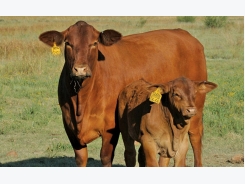Grass Silage: what you put in is what you get out

Pasture grass is regarded as the cheapest feed for SA dairy cattle. In the first of a four- part series, Wim Hofman, cattle specialist for De Heus Animal Nutrition, of the Netherlands, explains how careful pasture management can yield good grass silage.
Only finely chopped pasture grass of the right age should be ensiled for dairy cow rations. Photo: Wayne Southwood
Pasture-based dairy farming is widely practiced along this country’s eastern seaboard. With pasture grass being a dairy operation’s cheapest source of protein and energy, good pasture management is a key profit driver. Properly ensiled grass helps the pasture-based dairy farmer stretch his more expensive maize silage and milled concentrate rations.
“A pasture-based dairy cow’s typical daily ration consists of 50% to 60% roughage, while the rest is compound feed,” explains Wim Hofman, cattle specialist for De Heus Animal Nutrition.
“The intake of higher quality silage leads to increased consumption by a cow that, in turn, leads to improved health and fertility, increased milk production and profit for the dairy business,” he says.
High quality grass yields good quality silage. Grass cut and ensiled too late will have unpalatable, woody stems, while incorrectly ensiled grass could become mouldy and inedible .This leads to lowered intakes, with cows eating less dry matter (DM) and suffering exposure to potentially harmful bacteria and fungi. In addition, energy that could have been used for milk production will now be inefficiently used to digest poor quality grass silage. The dairy farmer will then have to maintain production with more costly maize silage and concentrates.
“By contrast, appropriate age pasture grass cut to the correct lengths and properly ensiled will lead to higher milk production without the need for increased roughage and concentrates,” says Wim.
When looking at the effect of dairy nutrition quality on milk production, De Heus uses the world standard – a dairy cow needs 460 units of energy (VEM) to produce 1kg of milk.
A 2013 De Heus study of maize silage quality in South Africa found that the bottom 10% of samples yielded an average of 780 VEM/kg, while the top 10% yielded an average of 970 VEM/kg – a significant difference.
The bottom 10% of maize silage samples in the study averaged 120g/kg DM, in comparison with the average 340g/kg in the top 10%. “So a cow eating the same quantity of good quality silage as a that of a cow eating poor quality silage will get more energy that can be used for milk production,” notes Wim.
De Heus also found that better quality roughage leads to increased intakes. Cows eating the top 10% of sampled roughage typically consumed 12kg DM/day of the roughage, containing 11 640 VEM, with 3kg/day concentrates, to milk an average 19,5l/cow/day.
Related news
Tools

Phối trộn thức ăn chăn nuôi

Pha dung dịch thủy canh

Định mức cho tôm ăn

Phối trộn phân bón NPK

Xác định tỷ lệ tôm sống

Chuyển đổi đơn vị phân bón

Xác định công suất sục khí

Chuyển đổi đơn vị tôm

Tính diện tích nhà kính

Tính thể tích ao



 Making the most of grass silage
Making the most of grass silage  Cross-bred or pure-bred: designing a herd
Cross-bred or pure-bred: designing a herd